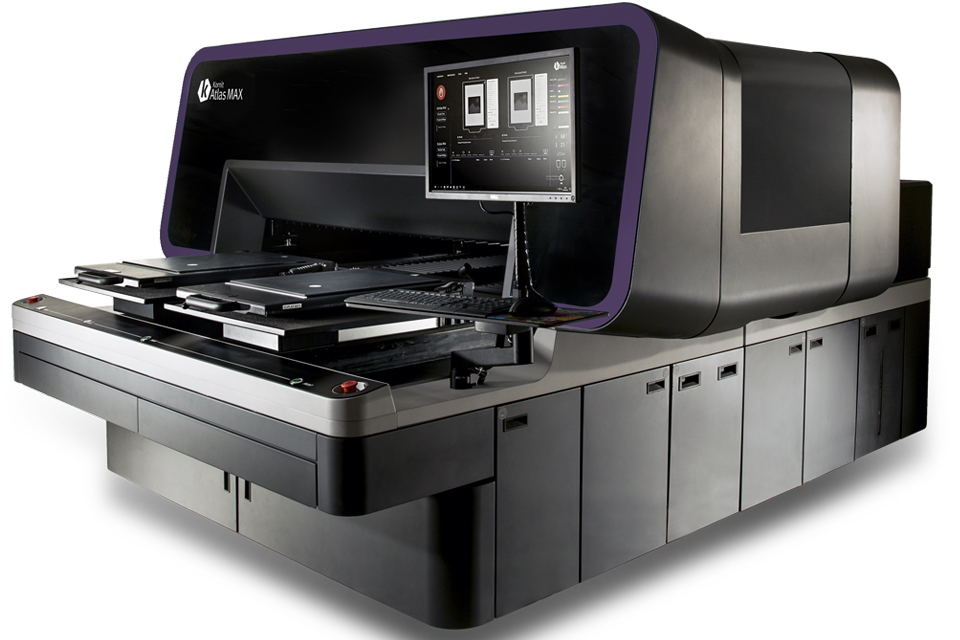3D printing and clothing manufacturing are strange bedfellows, with most marriages between the two involving some form of polymer textile that makes for interesting runway shows, but don’t seem as though they could make it onto the rack. However, we may see more 3D printing incorporated into the fashion world through a new digital textile printing technology from Israeli-American company Kornit Digital (Nasdaq: KRNT).
Digital textile printing, in this case a form of direct-to-garment (DTG) printing, is a process by which an inkjet printhead deposits colorant onto a fabric. Generally, Kornit’s process has involved pre-wetting a fabric within the printer, printing ink onto the textile, and then applying a fixing agent all within the printing system itself. To achieve full CMYK color on dark garments, it begins with a white coat of ink.
The new MAX technology makes it possible to deposit 3D layers onto fabrics. Dubbed “XDi”, this feature makes it possible to embed 3D objects onto textiles such that it can simulate embroidery, vinyl and heat transfer within a single process. In this way, XDi offers some of the advantages of 3D printing in that these 3D features are additive and, therefore, do not produce the same waste that comes from subtractive processes.
“This thing is highly durable. This thing actually withstand every standard out there. So, it’s not that we’re just sticking stuff on top of the fabric. This is as durable as our print. Think about it as a 3D layer printing with exactly the same characteristics,” said Omer Kulka, CMO of Kornit Digital during an unveiling event on April 26. “Now, important to say, I told you before these technological blocks are field proven. This is based on technology that we we’ve been using for years in our direct to fabric line of business. So, no, it’s not exactly the same product, but it is the same technology. We took a technology that is field-proven for years, and we imported it to the DTG world, improved it, and built those capabilities you’re seeing right now. The Atlas smacks on top of [the fabric], providing that complete control over the substrate actually has control on the, on the Z dimension, as well.”
Both DTG and its leading competitor, dye-sublimation, represent a new trend in on-demand clothing manufacturing. Through companies like vPersonalize, it’s possible to take digital models of garments, such as t-shirts and dresses, and produce sewing and cutting patterns that can then be produced with DTG or dye-sublimation. These patterns can be automatically graded to size, including custom sizing. Automated equipment can then follow guide lines for laser cutting, making it possible to produce individual garments on-demand. For instance, clients that use vPersonalize’s platform can offer consumers the ability to customize apparel, changing colors or adding names and emblems.

A collection created by designer Vivi Bellaish for Kornit Fashion Week using Kornit’s new technology. The “embroidery” on these garments was all printed. Image courtesy of Kornit Digital.
There are still a number of steps that would need to be automated in order to make the production of textiles fully automated, specifically robotic sewing, but we are seeing a similar trend occur in fabrics as we are in general manufacturing. If the printing, cutting and sewing of a t-shirt were to be fully automated, it would be possible to not only print a desired pattern onto the clothing, but also customize the exact silhouette and have it produced as a single item on demand.
“We develop a streamlined algorithm that can actually render 2D to 3D and create these amazing effects from a regular print. So, you can get a regular file and make it into a 3D embroidery file and vice versa,” Kulka continued. “You can actually simulate an embroidery or create something completely different and completely new from just a regular design. Some of the designs can actually never can even be embroidered. They just look like it, but it’s impossible in terms of complexity costs, time efficiency, et cetera.”
With Kornit’s XDi, this sort of DTG production goes beyond typical colored inks to produce embroidery and other embellishments that would typically require labor-intensive sewing and stitching. Kornit did introduce an additional automation feature, ActiveLoad, a robotic system that makes it possible to semi-automatically load the fabric into the printer without having to manually straighten it exactly onto the loading platform.
Kornit was founded in 2002 with veterans from the digital printing sector, including HP. It’s not surprising to see an Israeli company form based around inkjet technology, given the fact that Objet, the pioneer in inkjet 3D printing, was born there, as have been several other inkjet-based 3D printing firms, such as XJet and Nano Dimension. What is interesting is that it is focused on the textile space.
The closest competing technology to XDi that I’m aware of is Voxel8’s ActiveLab system, which is capable of depositing polyurethane onto fabrics. The main demonstrator application of the ActiveLab system has been the production of shoe uppers, which has previously been difficult to achieve with 3D printing. Although we’re still wondering what’s going on with Voxel8’s electronics 3D printing behind the scenes. There’s also Stratasys’s recent experiments with 3D printing onto garments.
How the capabilities of Kornit’s XDi process compare to something like what Voxel8 can achieve is hard to know. We’ve reached out to Kornit for more information on the technical aspects of the technology. The first system to include MAX technology is the Kornit Atlas MAX, which features the aforementioned XDi process. Customers with existing Kornit Atlas systems will be able to get an upgrade in the first quarter of 2022.
Subscribe to Our Email Newsletter
Stay up-to-date on all the latest news from the 3D printing industry and receive information and offers from third party vendors.
You May Also Like
Why Corrosive Resistant Materials Are Important to the Success of 3D Printing Across Industries
The adoption of additive manufacturing (AM) is accelerating across many major industries. As this technological shift unfolds, the importance of corrosion resistance has emerged as a challenge for 3D printing...
America Makes Announces IMPACT 2.0: $6.6M in New 3D Printing Funding
America Makes, the Manufacturing Innovation Institute (MII) based in Youngstown, Ohio, has announced IMPACT (Improvement in Manufacturing Productivity via Additive Capabilities and Techno-Economic Analysis) 2.0, a project call which will...
3D Printing Webinar and Event Roundup: April 14, 2024
We’re starting off the week’s 3D printing webinars and events at ASTM AMCOE’s 11th Snapshot Workshop and MACH Exhibition. Stratasys continues its advanced training courses, SME is holding a virtual...
AMUK Welcomes Airframe Designs as British 3D Printing Industry Grows
While the UK is not the hub for 3D printer and materials manufacturers as other nations, the country continues to excel at the research, development, and application of additive manufacturing...

































